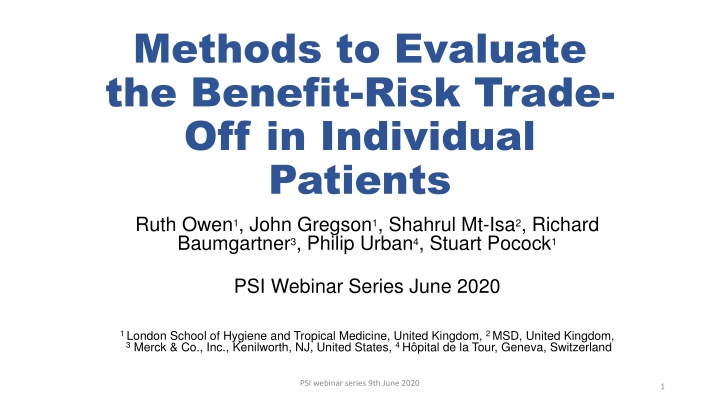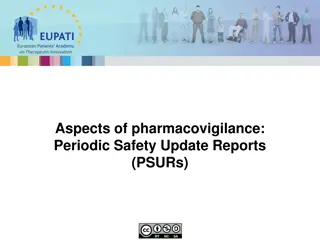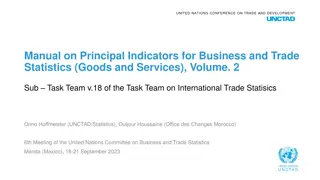Methods to Evaluate Benefit-Risk Trade-Off in Individual Patients
Evaluating benefit-risk trade-offs in individual patients is crucial for making informed treatment decisions, especially when safety concerns arise with new therapies. This involves developing statistical algorithms to identify cases where potential harm outweighs benefits, as illustrated in the TRA 20P-TIMI 50 trial. Traditional frameworks may overlook individual differences, emphasizing the need to apply trial results to specific patient characteristics for personalized decision-making.
Download Presentation

Please find below an Image/Link to download the presentation.
The content on the website is provided AS IS for your information and personal use only. It may not be sold, licensed, or shared on other websites without obtaining consent from the author.If you encounter any issues during the download, it is possible that the publisher has removed the file from their server.
You are allowed to download the files provided on this website for personal or commercial use, subject to the condition that they are used lawfully. All files are the property of their respective owners.
The content on the website is provided AS IS for your information and personal use only. It may not be sold, licensed, or shared on other websites without obtaining consent from the author.
E N D
Presentation Transcript
Methods to Evaluate the Benefit-Risk Trade- Off in Individual Patients Ruth Owen1, John Gregson1, Shahrul Mt-Isa2, Richard Baumgartner3, Philip Urban4, Stuart Pocock1 PSI Webinar Series June 2020 1 London School of Hygiene and Tropical Medicine, United Kingdom, 2 MSD, United Kingdom, 3 Merck & Co., Inc., Kenilworth, NJ, United States, 4 H pital de la Tour, Geneva, Switzerland PSI webinar series 9th June 2020 1
Introduction New treatments may be accompanied by safety concerns While overall results may demonstrate a favourable benefit-risk trade-off there may be individuals where the harm outweighs the benefit Useful to develop a statistical algorithm to aid decision-making by identifying such individuals PSI webinar series 9th June 2020 2
Example 1: TRA 20P-TIMI 50 trial 17,729 patients with a history of MI received vorapaxar vs placebo Primary outcome: CV death, MI, stroke Suspected possibility of increase in bleeding complications We assess GUSTO moderate or severe bleeding PSI webinar series 9th June 2020 3
TRA 20P-TIMI 50 trial results Ischaemic* events: HR: 0.79 (0.71 to 0.88), p<0.0001 742 (8.4%) vs. 597 (6.7%) Approximately 145 events prevented Bleeding events: HR: 1.61 (1.31 to 1.97), p<0.0001 241 (2.7%) vs. 151 (1.7%) Approximately 90 events caused *Primary outcome less hemorrhagic stroke which is considered a bleeding events: PSI webinar series 9th June 2020 4
Applying trial results to aid clinical decisions: traditional framework Increased risk of bleeding in trial population Decreased risk of ischaemia in trial population Treatment effects are averaged across patients, ignoring individual differences which may have an important impact on the likelihood of benefit/harm PSI webinar series 9th June 2020 5
Applying results to the individual patient Patient 1 Patient 2 Patient characteristic Age 55 77 Sex Male Female Haemoglobin 140 g/L 97 g/L 4.2 mmol/L 2.5 mmol/L Non-HDL cholesterol, mmol/L No Yes Thienopyridine use Is patient likely to benefit from Vorapaxar? Probably ? PSI webinar series 9th June 2020 6
Subgroup Analyses: Traditional framework Scirica et al. Lancet. 2012;380(9850):1317-24. PSI webinar series 9th June 2020 7
Subgroup Analyses: Traditional framework Limitations: Only one characteristic can be investigated at a time Subgroups are often more similar than different in terms of other characteristics Usually underpowered PSI webinar series 9th June 2020 8
Applying trial results: proposed individualised approach Individualised assessment of ischaemic risk Individualised assessment of bleeding risk Hazard ratio for bleeding Hazard ratio for ischaemia Individualised assessment of increased ischaemic risk Individualised assessment of increased bleeding risk Individual assessment of ischemia and bleeding risk achieved using multivariable Poisson regression models for each event PSI webinar series 9th June 2020 9
Multivariable predictive model for ischaemic events N HR (95% CI) 0.80 (0.72, 0.89) 1.93 (1.68, 2.22) 1.43 (1.23, 1.64) 1.44 (1.26, 1.64) 1.39 (1.23, 1.56) 1.61 (1.35, 1.92) 1.29 (1.13, 1.47) 1.67 (1.38, 2.03) 1.73 (1.01, 2.95) 1.35 (1.12, 1.63) 1.48 (1.21, 1.80) 2.17 (1.75, 2.68) 1.16 (0.89, 1.51) 1.44 (1.26, 1.63) 1.31 (1.11, 1.55) 1.42 (1.12, 1.78) 1.67 (1.24, 2.25) 1.07 (0.94, 1.22) 1.47 (1.25, 1.72) 1.20 (1.07, 1.34) 1.21 (1.05, 1.39) 1.33 (1.12, 1.58) 0.81 (0.71, 0.94) 1.15 (1.03, 1.28) P-value <0.0001 <0.0001 <0.0001 <0.0001 <0.0001 <0.0001 <0.0001 Treated with vorapaxar History of heart failure History of PAD History of hypertension History of unstable angina Prior cerebrovascular event Age, years(Ref <64): 65-74 8880 1554 1599 11094 4529 872 3928 1313 101 8287 4732 2202 623 3300 1782 676 271 9100 3480 6056 2408 1721 3595 75-84 85 Non-HDL cholesterol, mmol/L (Ref <2): 2-3 <0.0001 3-4 4 Non-insulin-treated diabetes Insulin-treated diabetes Haemoglobin, g/L (Ref 130): 120-129 <0.0001 <0.0001 110-119 <110 Smoking status: Ex-smoker <0.0001 Current smoker Drug-eluting stent implanted History of CABG Baseline creatinine clearance<60ml/min Female BMI, per 10kg/m2 0.002 0.007 0.001 0.004 0.02 PSI webinar series 9th June 2020 10
Multivariable predictive model for bleeding events N HR (95% CI) 1.58 (1.28, 1.93) Reference group 1.64 (1.23, 2.19) 2.58 (1.82, 3.65) 5.05 (3.38, 7.53) Reference group 1.87 (1.48, 2.36) 1.81 (1.28, 2.57) 2.63 (1.18, 5.86) 1.50 (1.14, 1.97) 1.45 (1.15, 1.83) Reference group 1.45 (1.14, 1.84) 1.44 (1.04, 1.98) 1.47 (1.10, 1.95) P-value <0.0001 <0.0001 Treated with vorapaxar Haemoglobin (g/L): 130 8880 15000 1782 676 271 12387 3928 1313 101 1599 11094 5149 9100 3480 1721 120-129 110-119 <110 Age (years): <65 <0.0001 64-74 75-84 85 History of PAD History of hypertension Smoking status: Never 0.004 0.002 0.01 Ex-smoker Current smoker Baseline creatinine clearance <60ml/min 0.009 Thienopyridine use at baseline 13855 1.51 (1.16, 1.96) 0.002 11 PSI webinar series 9th June 2020
Comparison of bleeding and ischaemic risks Overlap in predictors means patients at high risk of ischaemia tend to be high risk of bleeding But still substantial variation Need to understand how vorapaxar alters risk of each event PSI webinar series 9th June 2020 12
Predicted impact of Vorapaxar on bleeding / ischaemia Predicted decrease in ischaemic risk more than predicted increase in bleeding risk 15460 (87% of patients) Predicted decrease in ischaemic risk less than predicted increase in bleeding risk 2269 (13% of patients) PSI webinar series 9th June 2020 13
Applying results to the individual patient Patient 1 Patient 2 Patient characteristic Age Sex Haemoglobin 55 Male 140 g/L 4.2 mmol/L No 77 Female 97 g/L 2.5 mmol/L Yes Non-HDL cholesterol, mmol/L Thienopyridine use Other important characteristics 0.18 3.64 Predicted bleeding risk / predicted increase with Vorapaxar 1.06 1.63 Predicted ischaemic risk / predicted decrease with Vorapaxar Is patient likely to benefit from Vorapaxar? Yes No PSI webinar series 9th June 2020 14
Assessing individual benefit and harm Have a method for assessing increased risk/benefit trade-off But: Are bleeding/ischemic events of equal importance? How certain are we in our predictions of benefit/harm? PSI webinar series 9th June 2020 15
Assessing severity of bleeding/ischaemic events Risk of death following ischaemic events higher Ischaemic events should be considered more severe PSI webinar series 9th June 2020 16
Assessing severity of bleeding/ischemic events Bleeding event N=389 Ischemic event N=1339 No. deaths within 1-year post event 59 326 Risk of death 1-year post event1 0.159 0.250 Expected 1-year risk of death in absence of event2 0.023 0.009 Risk of death after event Risk of death in absence of event= Excess risk of death attributed to event 0.136 0.241 Relative importance of ischemic event compared to bleeding event 1.77 1 Kaplan-Meier estimate 2 Based on adjusted rate in absence of event PSI webinar series 9th June 2020 17
Assessing severity of bleeding/ischaemic events Predicted decrease in ischemic risk more than predicted increase in bleeding risk after accounting for different mortality risk Predicted decrease in ischemic risk less than predicted increase in bleeding risk after accounting for different mortality risk Equal importance: 87% patients more likely to benefit from treatment Accounting for different mortality risk: 98% more likely to benefit from treatment PSI webinar series 9th June 2020 18
Applying results to the individual patient Patient 1 Patient 2 Patient characteristic Age Sex Haemoglobin 55 Male 140 g/L 4.2 mmol/L No 77 Female 97 g/L 2.5 mmol/L Yes Non-HDL cholesterol, mmol/L Thienopyridine use Other important characteristics 0.18 3.64 Predicted bleeding risk / predicted increase with Vorapaxar 1.06 1.63 Predicted ischemic risk / predicted decrease with Vorapaxar 0.17 (0.06, 0.43) 2.23 (0.75, 5.96) No. bleeding events caused per ischaemic events prevented (95% CI) PSI webinar series 9th June 2020 19
Example 1 Summary Identified a set of patient characteristics which predict individual trade-off between ischaemic benefit and bleeding risk Majority of patients ischaemic benefit appears to outweigh harm Can also capture: Varying impact of each event on patient s mortality risk uncertainty surrounding individualised predictions PSI webinar series 9th June 2020 20
Example 2: High Bleeding Risk Trade-off DAPT after PCI reduces risk of coronary thrombotic events at the expense of increasing risk of major bleeding Combines data from 6 studies 6,641 high bleeding risk patients* treated with PCI Trade-off between thrombotic and bleeding events, defined as MI/stent thrombosis and BARC grade 3-5 major bleed * According to the Academic Research Consortium for High Bleeding Risk (ARC-HBR) criteria DAPT- Dual Anti-Platelet Therapy, PCI Percutaneous Coronary Intervention, BARC Bleeding Academic Research Consortium PSI webinar series 9th June 2020 21
Mortality after Bleeding & Thrombotic Events Adjusted HR = 6.07 Adjusted HR = 3.69 *From multivariable Cox proportional hazards model which included bleeding and thrombotic events as time-varying covariates and adjusted for predictors of death PSI webinar series 9th June 2020 22
Predicted 1-year risk of BARC 3-5 vs MI/ST Thrombotic risk = bleeding risk Equal mortality weighted trade-off 44% patient with bleeding risk > thrombotic risk 23% patients with bleeding risk > thrombotic risk taking mortality into account Assuming equal effect of DAPT on MI/ST vs BARC 3-5 bleed PSI webinar series 9th June 2020 23
Example 3: SPRINT trial 9361 patients with high SBP were randomised to receive intensive vs standard blood pressure control Lower rate of the primary efficacy composite (MI, other acute coronary syndromes, stroke, acute decompensated heart failure, or death from cardiovascular causes) vs increased rate of SAEs* 1-year mortality risk around 3 times higher after efficacy outcome than after safety outcome * Including hypotension, syncope, bradycardia, electrolyte abnormality and acute kidney injury or failure PSI webinar series 9th June 2020 24
Applying results to the individual patient Efficacy and safety outcomes considered of equal importance: Few patients with net benefit (11%) Decrease in primary outcome risk greater than increase in safety outcome risk accounting for different mortality risk Decrease in primary outcome risk less than increase in safety outcome risk accounting for different mortality risk Accounting for different risk in 1-year mortality: Net benefit for majority of patients (98%) PSI webinar series 9th June 2020 25
Conclusions When making individualised treatment decisions, it is important to weigh the potential benefits against the potential risk. To assist with this, a statistical tool can be constructed: 1. identify key patient characteristics which are predictive of efficacy and safety outcomes 2. quantify the relative importance of each event (in terms of mortality risk, alternatives?) 3. document the predicted benefit-risk trade-off for individual patients, allowing for the uncertainty in the process PSI webinar series 9th June 2020 26























